Bart Pushaw
In a woodcut printed in 1724, white polar bear pelts, tanned sealskins, and brown caribou hides billow like great sails from the masts of ships, as trumpets blare and thunderous timpani drums resound across choppy waters (Fig. 1).[1] Pictorial banners depicting Arctic fauna from cod and salmon, to walrus, whale, and narwhal, assume proud positions under the red-and-white flags of the Dano-Norwegian Empire. Amidst this pomp and circumstance, two Inuit men in hooded skin jackets navigate slender qajaqs (small, closed boats for single paddlers) between the large ships. One man, named Poq, grabs a duck by the neck, having shot it with his bow and arrow. The other, Qiperoq, firmly grasps his right hand around a bird dart, poised to propel it forward. As the stars of this spectacle, Poq and Qiperoq command a distinct visual presence, rendered at a markedly larger scale than their surroundings.
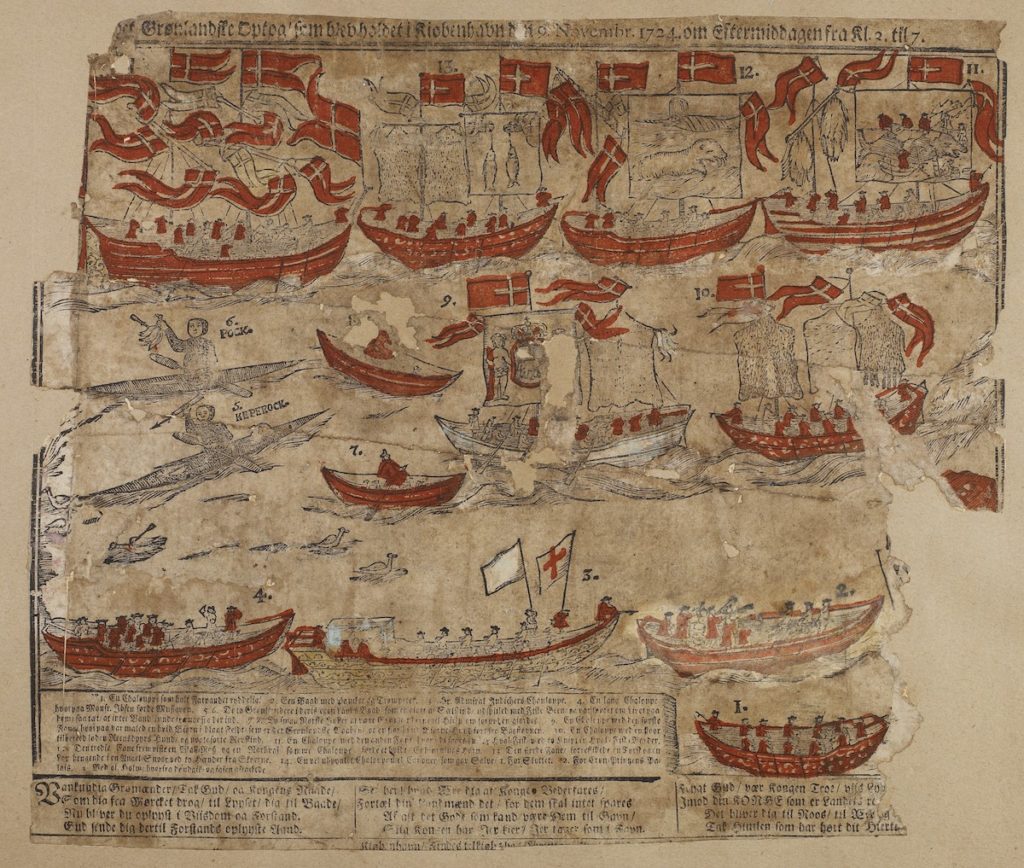
Known as the Greenlandic Procession (Danish: Grønlandske optog), this event was part of a campaign organized by the Bergen Greenlandic Company to raise funds for struggling colonial ventures in trade and missions in the Arctic, which had begun only three years earlier, in 1721.[2] Unlike the violent legacy of stolen and displaced Inuit in Europe, Poq and Qiperoq had made deliberate, voluntary decisions to travel with European missionaries and merchants from Kalaallit Nunaat (Greenland) to Denmark in the autumn of 1724.[3] Drawing some 75,000 enthusiastic spectators, the pageantry of Poq and Qiperoq’s procession exerted a profound impact on eighteenth-century Scandinavian visual culture, appearing in commissioned books, painted oil portraits, embroidered samplers, popular flyleaf prints, hand-colored woodcuts, and even a chinoiserie wall panel installed at the Prince’s Palace in Copenhagen (Fig. 2).[4] As diverse objects mediated the aesthetics of the procession into materials of colonial possession, each iteration presented Poq and/or Qiperoq as hunters. In doing so, these artworks consolidated a singular, restrictive vision of this significant eighteenth-century encounter between Inuit and Europeans.[5]
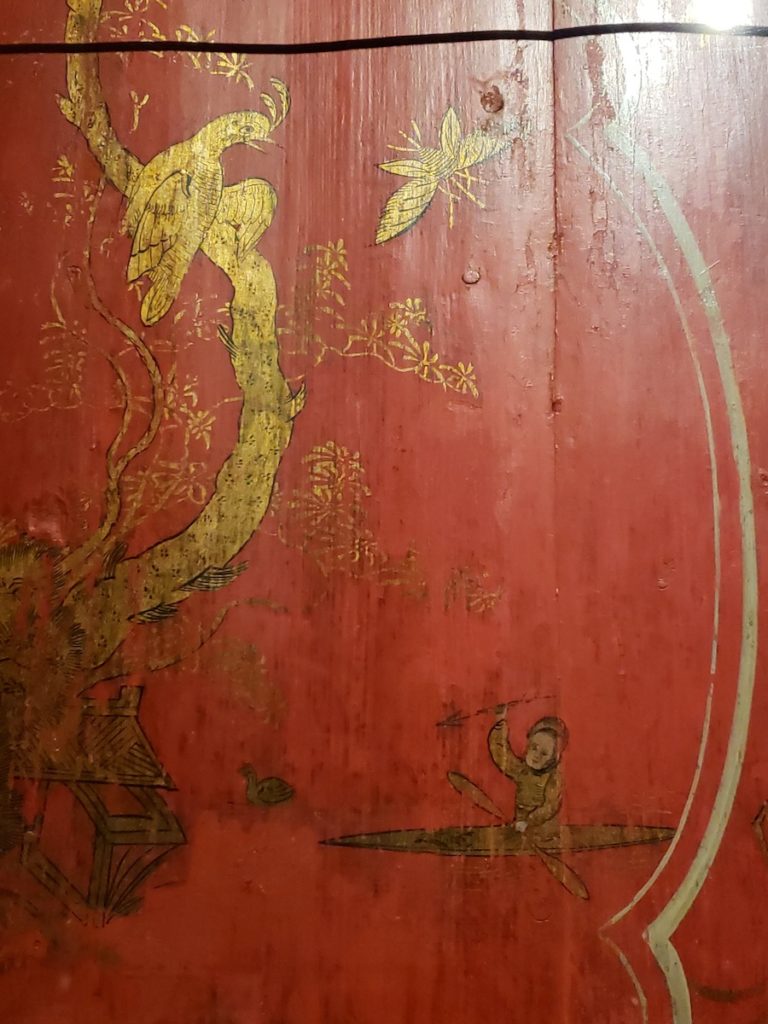
On May 25, 1725, Poq returned home, but without Qiperoq, who had succumbed to smallpox in Bergen. In an eighteenth-century archive wherein Indigenous cosmopolitanism was too often concomitant with disease and imminent death, records of Poq’s homecoming are remarkable.[6] Upon his return, Poq performed “songs which he had made about his voyage and the particular sights he had seen in [Europe],” inspiring Kalaallit (Greenlanders) to “see the country about which the now-returned Poq could recount so many lovely things.” [7] In these earliest, most formative years of colonial encounters between Inuit and Europeans in Kalaallit Nunaat, Poq sang with conviction to Inuit about his lived experiences of elsewhere.[8] Kalaaleq orality sustained such enthusiasm for Poq’s narrative across generations that the tale became the first Inuit-printed book: Poq, a Kalaaleq Who Travels and Tells a Story to His Countrymen upon His Return to Land (henceforth, Poq…), produced by the Inuk artist, poet, and publisher Rasmus Berthelsen (1827-1901) in 1857.[9]
As the first Inuk to complete the colonial circuit between Kalaallit Nunaat and Denmark, Poq communicated elsewhere with an authority that was ideal subject matter for Rasmus Berthelsen to visualize in the experimental early days of the Nuuk printing press. To illustrate the book, Berthelsen created four hand-colored woodcuts of Poq and Qiperoq in Copenhagen (Fig. 3). These woodcuts are the first Inuit images of colonial history as well as the earliest known examples of Inuit printmaking, a vital subfield of Indigenous art histories of Abiayala (the Americas).[10] The prints reveal a nuanced narrative of what the two travelers experienced in Europe beyond their procession—and performance—in the canals. Across the images, dapper Inuit saunter along the cobblestone streets of the city, contemplate nature as they promenade in a lush forest, ride a horse-drawn carriage to visit the king, and enter the Royal Palace. In their sartorial trappings, the Poq and Qiperoq of Berthelsen’s woodcuts appear to be denizens of the nineteenth century. However anachronistic these details may seem, they are complex expressions of Inuit temporalities of the eighteenth century.
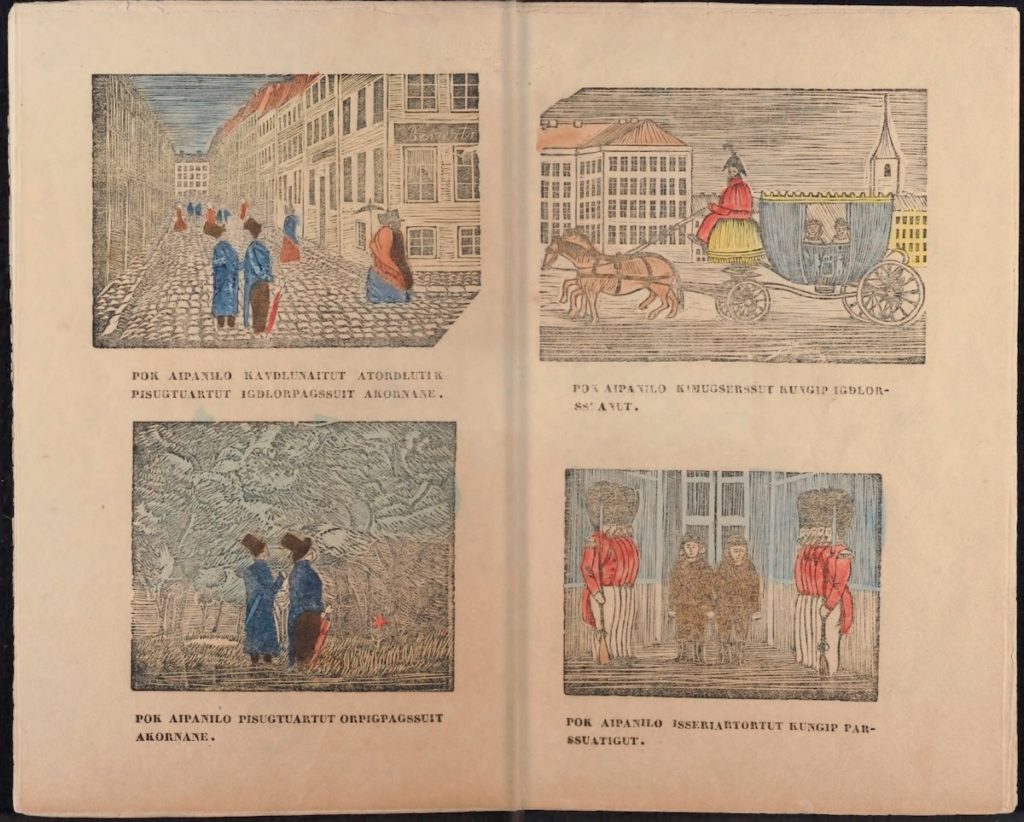
The objects that might constitute an eighteenth-century Inuit art history remain difficult to discern.[11] In what follows, I frame Rasmus Berthelsen’s Poq… illustrations as one node in the emergent art historical mapping of the Inuit eighteenth century. The nineteenth-century manufacture of the images invites consideration of how Indigenous and specifically Kalaallit epistemologies put into question the methods by which art history considers periodization. 1857 certainly pushes at the limits of a long eighteenth century, but only insofar as the discipline is concerned with a singular, progressive trajectory. Instead, I argue that the Inuit temporalities manifested in Berthelsen’s carvings demand the art historical recognition of what Mark Rifkin has called “temporal sovereignty,” a mode of attending to the manifold Indigenous conceptions of time and duration that often press up against, interlace with, and transcend the (settler) colonial construct of linear time.[12]
This article contends that Rasmus Berthelsen’s illustrations of Poq… comprise a tangible visual archive of Indigenous embodied presence in the wider eighteenth-century world. Rather than a strict adherence to unfolding chronology or a sequence of events, Inuit historicity prioritizes sophisticated conceptions of space, mobility, and circulation to understand time and duration. By drawing on the spatial dimensions of temporality and storytelling so essential to Inuit knowledge, I posit that Berthelsen’s strategic use of novel reproductive media—particularly woodcut prints—communicated significant stakes in the Kalaaleq grappling with colonial linear time and its attendant notions of temporal distance and proximity.[13]
Respecting Poq’s temporal sovereignty—and the integrity of Berthelsen’s iconography as it appears—stakes a claim for colonial Inuit art as crucially constitutive of the itinerancy of global eighteenth-century art worlds.[14] Made by Kalaallit to circulate among Kalaallit at home, these images did not cross the geographical borders typically presumed within art historical narratives of mobility. As we will see, an itinerant art history need not be predicated upon the physical movement of art objects, materials, nor an anticipatory mobility shaping the facture of artworks.[15] Instead, the reproductive logics of the woodcut enabled artists to express a vital fact about the story of Poq and Qiperoq: their experience evinced a radical remapping of the spatial dimensions of Inuit temporality under ongoing colonial circumstances.
Inuit Literacies and the Promise of Pictures
Produced by Indigenous bookmakers for a Kalaaleq audience, Poq… is a rare archival source into Inuit transatlantic cosmopolitanism of the eighteenth century.[16] The book does not attribute authorship to Poq, but instead to “old writings found among inhabitants of Nuuk,” a veiled reference to the fact that Berthelsen sourced a 1760 version of Poq’s tale written by the European missionary Poul Egede.[17] Originally published as an appendix to Egede’s Kalaallisut-Danish-Latin dictionary, this 1760 text (as well as its 1857 reproduction) is framed as a dialogue between Poq and a shifting set of four inquisitive characters: Simik, Kujaut, Persoq, and Tulugaq.[18] Qiperoq is never named, but is referenced briefly as a “companion” (aappaq). As historian Michael Harbsmeier has posited, the dialogue stages Inuit orality as “an exercise to be used in the European classroom.” [19] This pedagogical format likely derives from observations written in 1725 by the missionary’s father, Hans Egede, about Poq’s return to Kalaallit Nunaat.[20] Since the 1857 text is not a direct Kalaaleq transcription of Poq’s performance, this history of missionary mediation reveals that the text, as well as Berthelsen’s corresponding illustrations, were already inextricable from the colonial circumstances of knowledge production in the period.[21]
As missionaries recorded Poq’s tale in writing, Kalaaleq orality sustained the tale beyond Poq’s physical demise in 1729, transforming his audience from curious and diligent listeners into authoritative storytellers whose proximity to Poq enabled them to recreate the narrative across generations.[22] Performed as late as 1961, Poq’s tale was alive and well among Kalaallit when Berthelsen conceived of and printed his illustrations.[23] Kirsten Thisted has argued that the colonial Inuit intellectuals who codified Kalaaleq storytelling in text and image did so “without omitting the vivid details and the power of oral performance,” bridging temporal distances between past and present.[24] However, I would argue that a distinction must be made between the transference of orality into written language and transference into Inuit visual culture.
Since Lutheran evangelism had spurred European missionary presence in Kalaallit Nunaat, individual literacy in the vernacular language was a key pillar of the Danish colonial project.[25] In his 1767 History of Greenland, Moravian historian David Crantz claimed that Kalaallit had once feared the “speaking paper,” but later became “such good scribes as to send their petitions and promissory notes to the factors, in which they mark the wares they want to borrow with coal upon a piece of skin.” [26] Writing with coal on animal skin was a clear indication of the Inuit adaptation of their norms to a new form of communication, as they expanded their lexicon to accumulate new meanings. For instance, the base atuaq-, “to follow a track,” would adopt the meaning of “to read” and later form atuagaq, “book.” [27] Such semantics evince how textual literacy could take root in Kalaallit Nunaat because of the diverse oral, material, and social literacies that Inuit had already nourished for centuries before missionaries arrived.[28]
Writing enjoyed a century of precedence among Kalaallit that image production on paper did not. As scholarship on Indigenous literacies emphasizes modes of Native adaptation to new colonial cultures of communication, many scholars addressing the development of Inuit visual literacy stress that the eighteenth century’s inauguration of Arctic coloniality disrupted cultural continuities.[29] In the Kalaaleq context, they do so by drawing attention to the 1871 neologism for “art,” eqqumiitsuliorneq, and its related semantics to “strange,” eqqumiippoq, in order to stress the supposed alterity of art-making in relation to Inuit customary practices.[30] Since a non-Inuk linguist coined eqqumiitsuliorneq over a decade after Berthelsen produced Poq…, I posit instead that the rich semantics of the Kalaallisut word for image, assiliaq (pl. assiliat), are crucial to understanding the cultural work of the artist’s images for the book’s intended Inuit audience, elucidating how the images manifest Inuit historicity and temporality.
Speakers of Kalaallisut today specify a woodcut print as qisummut kigartuaq. In the colonial period, Kalaallit preferred the expansive word assiliaq as the translation for “woodcut.” [31] The intricate semantics of assiliaq and its root assi- convey notions of resemblance, reproduction, and copy. The verb “to depict,” assilivoq, shares these semantics with the verb “to remind,” assinguvoq. “Map,” nunap assinga, also falls into this conceptual category, with loose translations encompassing “a copy of the land,” “a resemblance of the land,” or even “a reminder of the land.” As resemblance, reminder, reproduction, and copy intermingle in the Kalaaleq meaning of “image,” assiliaq shares the priorities of the story, whose narrator recalls and recreates the past in each iteration of their performance. If, as Mark Rifkin contends, “temporal experience itself might be understood as intimately imbricated with story,” then the generative capabilities of printmaking became essential to expressing the Inuit temporality of Poq… under the conditions of colonial time.[32]
Whereas many languages distinguish between the past and the present by verb tense, Inuit languages prioritize distinctions between the present and the future, with no corresponding past tense.[33] This future-oriented outlook derives from the imperative of mobility that had been at the core of Inuit life. Adaptive and experiential, Inuit notions of time prioritize the space through which one is moving.[34] To that end, Poq… is not a narrative record of 1724, but instead a mediation on the experience of elsewhere beyond Kalaallit Nunaat. No longer confined to the geographical spaces of the Arctic, Kalaaleq mobility increasingly forged cultural, social, material, and metaphysical pathways to and from Denmark. Since the eighteenth century, coloniality fostered (and forced) increasing intimacy between these spaces, as constant transatlantic circulation reconfigured traditional trajectories, expanding the possibilities of what Inuit temporality could express.
Inuit Internationalism
The flowing blue tailcoats and tall black hats donned by the itinerant Inuit of Rasmus Berthelsen’s imagery bear a conspicuous resemblance to fashions of the nineteenth century. There is a pragmatic reason behind this iconography. In 1843, Berthelsen followed in Poq’s footsteps, undergoing the six-week journey from Nuuk to Copenhagen by ship at the age of sixteen. The artist lived in Denmark for almost four years in the 1840s, granting him the cultural authority to depict a place that few Kalaallit had experienced in person.[35] Since Inuit temporality prioritizes a spatial where, rather than a chronological when, it is erroneous to consider the nineteenth-century clothing of Qiperoq and Poq to be anachronistic. Instead, the spatial dimensions of Inuit temporality encourage the Kalaaleq reader to understand the European dress of Qiperoq and Poq as evidence of their successful acclimation to foreign spaces.
The travelers deploy these sartorial trappings in two separate images arranged in a column on the same page: on the top, Poq and a Friend Dressed like the Europeans Stroll Among the Many Houses (Fig. 4) and on the bottom, Poq and a Friend Stroll Among the Many Trees (Fig. 5). The artist repeats the figuration of the young men across these two images with striking similarity. Almost identical, each pairing features Qiperoq and Poq in conversation with each other, echoing the dialogic format of the text. One turns his head towards the other, who gazes upwards in contemplation. Anonymized in the text, Qiperoq becomes in Berthelsen’s images a visual avatar of the avid Inuk reader, who experiences a distant land alongside Poq.
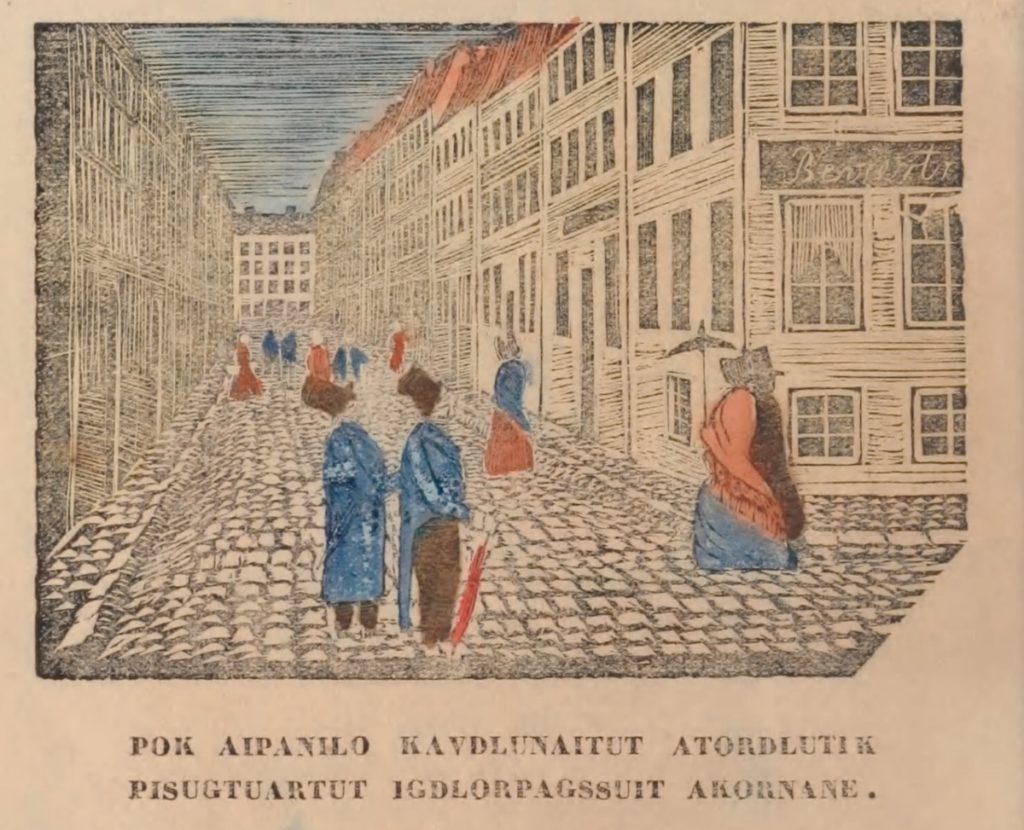
The recurrence of introspective Inuit across the two images on the page permits viewers to grasp the breadth of their experiences, oscillating between hard cobblestone streets and soft blades of grass, imposing architecture and endless forests, bustling streets, and tranquil trees. In the street scene, the artist carved an angled one-point perspective to convey Poq’s comment to Simik that “there are so many houses that they cannot be counted.” [36] The soaring appearance of the architecture, therefore, corresponds with how structures consist of “two, three, four, or five dwellings on top of one another.” [37] Poq and a Friend Stroll Among the Many Trees (Fig. 5), however, has a more opaque relationship to the book’s text. Having learned about the city’s large population, Simik surmises such a community would need to hunt at least twenty whales per day to sustain itself.[38] Poq explains that, unlike Inuit, Europeans practice agriculture, reaping the benefits of “trees that bear tasty fruits, some as large as a person’s head.” [39] This single mention of a tree (orpik) is the only explicit place in the story’s text where Poq addresses plants, therefore the artist’s choice to illustrate this particular encounter warrants scrutiny.
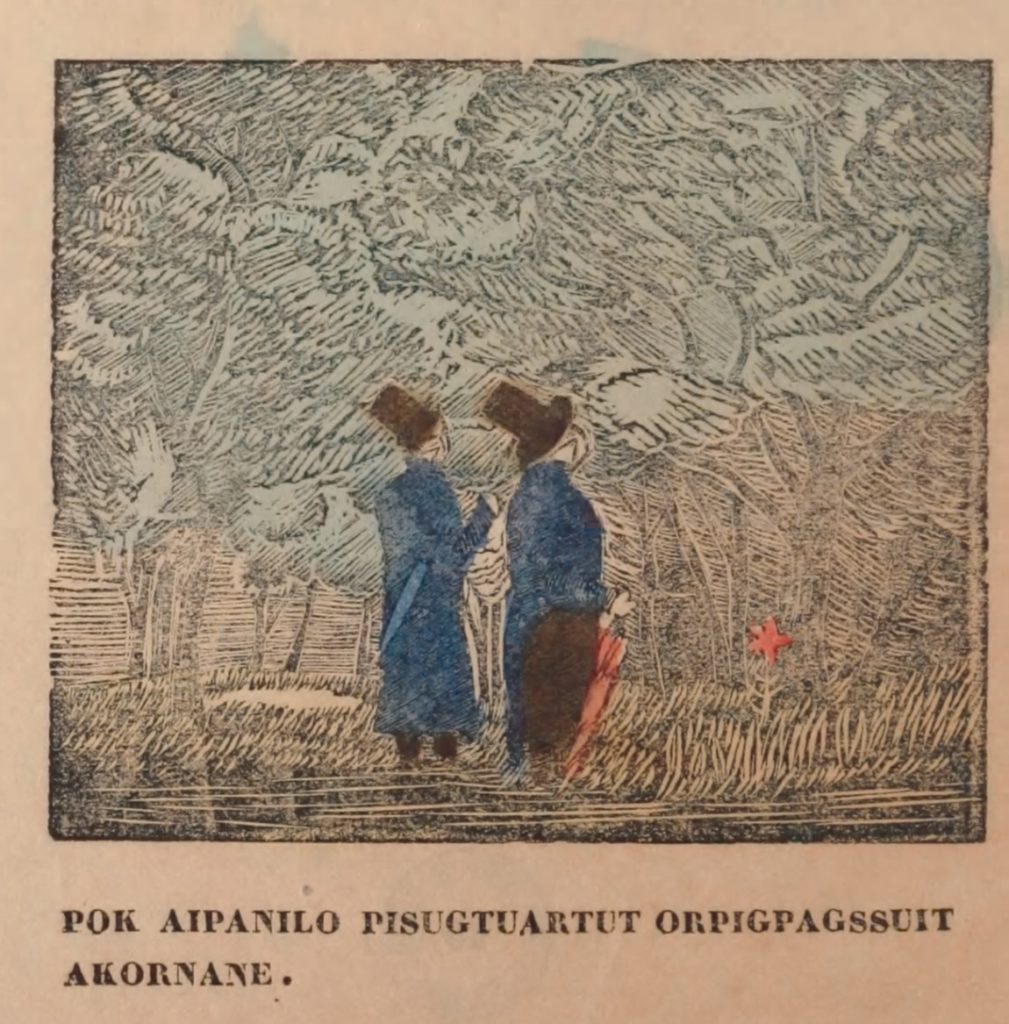
Despite a low horizon line, the geometric pattern and horror vacui of the lush crowns and thick black trunks thrust the figures towards the surface of the picture plane and flatten any illusion of three-dimensional space. Inked chlorophyll bleeds through the top of the woodcut. The red parasol, a fashionable walking stick in the street scene, assumes a different pictorial purpose in the forest image: it highlights an affinity with the vibrant red petals of a single blossoming flower. With its starburst-shaped, sun-seeking bloom, this small flower reveals how the artist utilized a restricted color palette to draw attention to the ways in which Poq and Qiperoq forged new kin among the botanical beings of elsewhere.[40]
Upon closer inspection of the top half of the print, the artist’s technique in his rendering of the green crowns of the trees reveals a pulsating dynamism. The rhythmic movement between raised and recessed spaces of the woodcut creates an abstract collision of blunt jagged edges with smooth curves. Lines twist into a nebulous network that captivates the young men, inspiring contemplative conversation. In carving this vigorous linear language, the artist was thinking deliberately about how best to communicate the mass and density of this new verdant world in pictorial form. The forest (orpippassuit, lit. “many trees”) was certainly a curious sight for Inuit, and its distinction from the treeless Arctic tundra is also at play here. However, I would argue that the Inuk artist dedicated the majority of the composition of Poq and a Friend Stroll Among the Many Trees as a pictorial invitation for Kalaallit readers to confront difference through a consideration of similarity. The abstract language of the carving operates as a site to ponder the profound implications of a brief statement in the text, namely that there exist conceptual correspondences between the social, cultural, and nutritional nourishment of a whale among Inuit and the multifaceted function of forests for Europeans. Poq and Qiperoq stand immersed in this abundant landscape, revealing how the trees also respond to and embrace the presence of the travelers.
The duplication of the motif of contemplative figures “dressed like the Europeans” signifies that we must understand that Qiperoq and Poq make relations in both instances, their worldview perceiving the living beings of the forest as well as those of the bustling urban space of the European city. The differences in spatial composition between the images are also laden with significance. As buildings soar beyond the picture plane of the street scene, the perspective emphasizes the density of the city (“there are so many houses they cannot be counted”). The artist’s vibrant lines and purposeful use of color in the forest scene—dominant green trees, a single red flower—convey what Dylan Robinson (Stó:lō) calls the “sensual experience of place” within the cultural authority of Indigenous song, one that is directly related to Inuit cultural protocol.[41] Whether depicting the city or the forest, Berthelsen’s images expand beyond the written text to express Qiperoq and Poq’s affective, sensorial experience of navigating elsewhere, cultivating a visual literacy among Inuit readers so that they know how to move in the wider world.
Making Images Nunalikkami
Berthelsen’s complex linear language was the direct result of the novelty of printmaking in the Kalaaleq context. In the field of Inuit art history, the notion of “early printmaking” does not typically encompass Inuit artists working before the twentieth century. Instead, “early printmaking” refers to the vibrant artistry that began in Kinngait, Qiqiktaaluk under the auspices of the Canadian government circa 1957.[42] Produced precisely one century earlier, Berthelsen’s woodcuts call into question the categories of periodization (“early” or “late”). More importantly, the images demand that accounts of the historicity of Inuit printmaking must address its spatial relations of production.
In March 1857, a new colonial administrator sent two small presses to Nuuk, the largest settlement, “to make Greenlanders familiar with the decisions and measures taken by the Government.” [43] Once the presses arrived to Nuuk in June 1857, Berthelsen worked with his apprentice Lars Møller to teach themselves the fundamentals of print culture. Printing letters in ink onto paper was a skill that the novice printers learned alongside experiments with creating and carving an image. It is astonishing that, mere months after working with a press for the first time, Berthelsen and Møller designed, formatted, typeset, illustrated, and printed Poq… by the end of the year.[44] Printed text in Kalaallisut circulated as early as 1739, but before the 1857 publication of Poq…, almost none of it was printed in the Arctic.[45] Europeans had produced bibles, psalms, dictionaries, grammars, and other books in Kalaallisut at printing presses most often in Denmark, the colonial authority, or in Germany, the homeland of Moravians who ran competing local missions in Kalaallit Nunaat between 1733 and 1900. In their production of the first Inuit-printed book, Berthelsen and Møller upended this cycle of colonial knowledge printed elsewhere and by outsiders, inaugurating new possibilities for Inuit to create and circulate print media by and for themselves.[46]
The production of Poq… on new printing presses in Kalaallit Nunaat recalled the cultural priorities embedded in the title of the book. The full Kalaallisut title does not emphasize the content of the story, but rather the location where Kalaallit (nunaqqat) listened to Poq: nunalikkami, “upon his return to land.” Common translations of this phrase into colonial European languages simplify nunalikkami as “at his homecoming” (Danish: ved sin hjemkomst), but the word operates within a distinct Inuit cultural imperative of mobility in the Arctic. Nunalikkami implies a return to land from watery domains. Linguists have clarified that the distinctions and relations between land (nuna) and sea (imaq) remain crucial to the conceptual and cultural encoding of space in the language.[47] Intimate navigational knowledge of water informed almost every aspect of the coastal-oriented culture of Kalaallit Nunaat. Waterways connected communities and abundant seas nourished Inuit because they were careful to maintain a cycle of obligatory reciprocity with all beings. There exists another semantic layer within nunalikkami beyond its locative function: it marks a moment of generous dissemination, whether a bountiful harvest or accrued experiential knowledge, as in Poq’s narrative. Marking the successful completion of a circulation, nunalikkami is a spatial prioritization of time.
Like Poq, Berthelsen had also returned home with extensive experiences of Denmark. In the midst of experimenting with printmaking for the first time, the artist could carve, color, and print illustrations for Poq… so deftly in 1857 because he created them nunalikkami, with the embodied knowledge of having returned from elsewhere. This protocol enabled the artist to imagine compositions that elaborated upon succinct text, dedicating space to the verdant worlds that he knew his itinerant forbearers once encountered in 1724.
Poq’s Iceberg
Rasmus Berthelsen’s lived experience informed his conception of the compositions of the images. Consider, for instance, how Berthelsen used scale, not only in the varied sizes of the images, but even in the scale of the figures across the woodcuts. While Poq and Qiperoq may appear small in comparison to tall buildings and lush flora, they are also, importantly, shorter than the European royal soldiers. These elements of scale, with no specific correspondence with the text, embody the artist’s own felt or affective knowledge. As a young adult in 1840s Denmark, Berthelsen knew well of the relative height difference between Inuit and Europeans.
This felt knowledge of scale in the elsewhere beyond Kalaallit Nunaat comes explicitly to the fore in the images of Poq and Qiperoq and the Royal Palace. In Poq and His Friend Travel to the King’s Great House (Fig. 6), the pair peers out of the window of an elegant horse-drawn blue carriage, its driver sporting a red jacket and bicorn hat with a plume. The intrepid Inuit are barely visible as the artist shifts focus from the travelers’ view of the city to the technologies they used there. The black reins of the brown horses curve at the far left of the image before forming into a taut line, which draws the viewer’s attention towards the sharp tip of the driver’s black bicorn hat, the point of this triangular composition. The artist carved slanted lines inside the wagon behind the heads of Poq and Qiperoq, directing the composition downwards toward the large wheels at the back of the carriage. The largest wheel, like the snout of the horse on the left side of the print, pressures the edges of the picture plane, creating a sense of immanent dynamism. If European images of Poq and Qiperoq consolidate a colonial gaze onto the qajaq-paddling newcomers, Poq and His Friend Travel to the King’s Great House prioritizes European modes of mobility in ways that require further clarification.
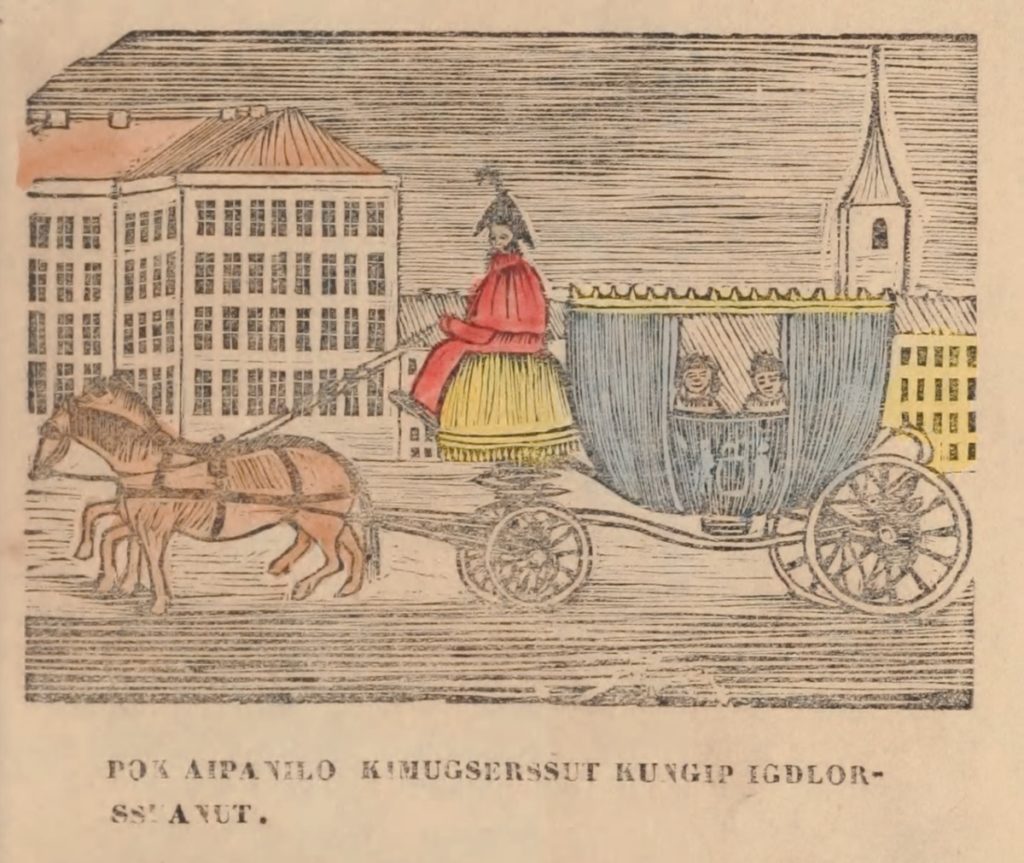
In the text, Poq explains to Persoq, one of the audience members, that once the procession in the canal had ended, the two travelers rode “a sled that was like a house with windows to the great and powerful king,” equating the mobility of an Inuit dogsled (qamutit) with a European horse-drawn carriage.[48] The text never mentions dogs (qimmit) or horses (hiistit, a loanword), yet thinking about shared modes of animal-led mobility informs how Poq, and later Rasmus Berthelsen, renders Europe in Indigenous terms.
To be sure, the wheels of a European carriage were distinct from how Inuit technologies utilized the slick flatness of the sled to navigate swiftly across ice and snow, but the cultural and geographical differences that fostered these parallel technologies of mobility are not the point of Poq’s narrative nor Berthelsen’s images here.[49] Instead, let us consider how Persoq responds to Poq’s description of the carriage. Persoq asks, “What is the great house [the Royal Palace] like?” Poq replies, “It is like a great iceberg.” [50] This simile invites a reconsideration of how the Inuk artist represented the eighteenth-century built environment of Copenhagen. Berthelsen carved windows of the palace to delineate the building with blank white negative space. A copper roof vies for skyline dominance with the towering spire of a church, whose forms the artist echoes in the point of the driver’s hat. The five-storied palace resembles how Berthelsen depicted other buildings in the bustling city street (Fig. 4). If the artist’s other spatial compositions emphasize a certain aesthetics of proximity—whether the density of “many houses” in the city or the intimate environs of the forest—it is remarkable that Poq and His Friend Travel to the King’s Great House features a distinct empty space between the carriage and the buildings.
It is here where the resemblance of the horse-drawn carriage to the sled is crucial. Filling the brim of pictorial space, the European “sled” mobilizes Poq and Qiperoq throughout this unfamiliar landscape. As cultural geographer Claudio Aporta has argued, “places made sense in the context of moving” for Inuit.[51] The palace-as-iceberg is therefore not only a simile of scale, but also an orientation in space that demands precariousness. Sturdy in its immense size, the iceberg (sg. iluliaq, pl. ilulissat) drifts slowly, appearing to be a permanent feature of the landscape, even immobile. Icebergs calve from glaciers suddenly and without warning, so Inuit know to use caution while moving in their dangerous vicinity.[52] No mere anchor in pictorial space, the palace-as-iceberg looms in the background, as the travelers keep a safe and sensible distance, unsure of what awaited them.
The Inuit Eighteenth Century
Kalaallit long recognized the potential of assiliaq as a pictorial tool of reminder and resemblance, but it was not until printmaking became available in 1857 that artists could realize expressive possibilities that accorded with articulating the past in spatial terms. As soon as printing presses arrived in Nuuk, Kalaallit harnessed the novel image technologies of the woodcut to facilitate their priorities. By producing Poq… nunalikkami, Berthelsen took a critical step towards reorienting the spatial logics that had normalized coloniality. As Poq and Qiperoq enter the palace (Fig. 7), surrounded by towering Danish soldiers, they confront the viewers directly and the future head-on.
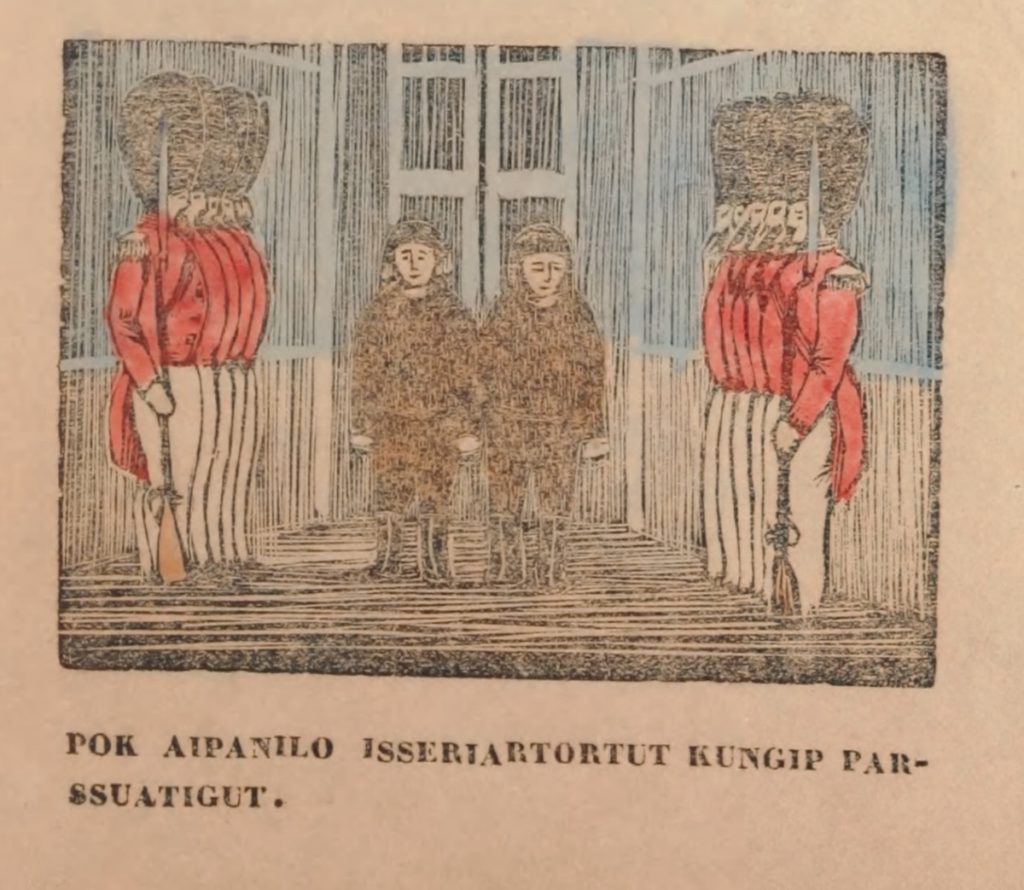
As the 1720s slowly entangled Kalaallit Nunaat and Denmark into a new spatial configuration, Inuit temporality remained future-oriented. The aesthetic and material choices that illuminate Berthelsen’s nineteenth-century framing of 1724 reveal that Poq’s temporal sovereignty becomes visible once it is on the move. If Kalaallit epistemologies establish temporal sovereignty as critical to the future writing of itinerant eighteenth-century art histories, we might best understand eighteenth-century Inuit art history as elusive by its very nature.
Bart Pushaw is a New Carlsberg Foundation and Mads Øvlisen Postdoctoral Fellow in Art History at the University of Copenhagen
Acknowledgments: Many thanks to Sarah Betzer and Dipti Khera for their unwavering support and careful shepherding of this study, and to the anonymous peer reviewers, whose gracious critique facilitated a re-conceptualization at crucial points. I am also indebted to conversations with Nivi Christensen, Mathias Danbolt, Kirstine Møller, and Liv Majer Larsen, as well as to Rogelio Cerezo and Caroline Paganussi for their editorial prowess. The writing and research of this article is indebted to the New Carlsberg Foundation Project “The Art of Nordic Colonialism: Writing Transcultural Art Histories” at the University of Copenhagen.
[1] This study prioritizes Indigenous names and follows conventions of the grammar of Kalaallisut (West Greenlandic), wherein the ethnonym Inuit changes based on the subject: Inuk (singular), Inuit (plural). I also use the words Kalaaleq (singular) and Kalaallit (plural) in lieu of the English word “Greenlander,” a practice many Kalaallit deployed themselves when writing in foreign languages in the eighteenth and nineteenth centuries. All translations from Kalaallisut and Danish are by the author unless otherwise noted.
[2] H.B., Egne-Tanker over det Grønlandske Optog, som blev holdet i Kiøbenhavn den 9. Novembr. Anno 1724. Med deres Dragt, Roen, Piileskyden og Andet Meere sin udaf efterfølgende Forklaring nærmere kand erfahres. Enfoldeligen forestillede af den, der ønsker Enhver, paa vel Nærværende som Fraværende Herrens Beskiørmelse (Copenhagen: 1724).
[3] On this history, see Johannes Balle, “Grønlændaren Pôk. Hvorledes han kom til Danmark, hans oplevelser der, og hvad han fortalte sine landsmænd derom, da han kom tilbage,” Tidskriftet Grønland 9:1 (1964), 321-348. Michael Harbsmeier, “Bodies and Voices from Ultima Thule: Inuit Explorations of the Kablunat from Christian IV to Knud Rasmussen,” in Michael Bravo and Sverker Sörlin, eds., Narrating the Arctic: A Cultural History of Nordic Scientific Practices (Canton, MA: Science History Publications, 2002), 33-74. Ole Høiris, “Inuitters beretninger om optræden i Danmark, Europa, og USA,” in Ole Høiris, Ole Marquardt, and Gitte Adler Ramer, eds., Grønlændernes syn på Danmark (Århus: Aarhus University Press, 2019), 303-363. For an art historical approach to images of captive Inuit, see Christopher Heuer, Into the White: The Renaissance Arctic and the End of the Image (New York: Zone Books, 2019), 80-120.
[4] For an excellent overview of the iconography of Poq and Qiperoq, see Verena Traeger, “Poq og Qiperoq—to eskimo portrætter,” Årbog (Kronborg: Handels- og Søfartsmuseet, 1992), 117-144. On the appearance of Qiperoq in eighteenth-century chinoiserie panels, see Josefine Baark, “Fair Game: The Cross-Cultural Chase in Eighteenth-Century Denmark,” Art History 43:2 (2020), 337-359, here 346-352.
[5] Marianne P. Stopp, “Eighteenth Century Labrador Inuit in England,” Arctic 62:1 (2009), 45-64. Coll Thrush, “The Iceberg and the Cathedral: Encounter, Entanglement, and Isuma in Inuit London,” Journal of British Studies 53:1 (2014), 59-79. Cecilia Morgan, Travellers through Empire: Indigenous Voyages from Early Canada (McGill-Queens University Press, 2017). For an art historical perspective, see Jessica Horton, “Ojibwa Tableaux Vivants: George Catlin, Robert Houle, and Transcultural Materialism,” Art History 39:1 (2016), 124-151.
[6] In 1729, Poq, under his baptismal name Christian, and his family traveled again to Denmark, where they all suffered a tragic bout with smallpox.
[7] Hans Egede, Omstændelig Relation angaaende Den Grønlandske Missions Begyndelse og Forsættelse (Copenhagen: Johann Christian Groth, 1737), 198, 180.
[8] Christian Berthelsen, “Puup pitsiaa,” Kalaaleq 5:1 (1994), 3-7.
[9] Rasmus Berthelsen and Lars Møller, Pok, kalalek avalangnek, nunalikame nunakatiminut okaluktuartok. Angakordlo palasimik napitsivdlune agssortuissok (Nuuk: Nalagkap Nongmitup Nakitirifik, 1857) (accessed October 23, 2021). The full title in modern Kalaallisut is: Pooq, Kalaaleq avalanneq, nunalikkami nunaqqatiminut oqaluttuartoq, angakkorlu, palasimik naapitsilluni assortuisoq, allakkat pisoqqat nassaarisar nuummiut ilaanit.
[10] There is one example of an image carved and printed at the Moravian mission in Noorliit in 1793. It remains unknown if the author of the image was a European missionary or an Inuk neophyte. See Jesper Broderson, Tuksiautit akioreeksautikset Makpersægangocesa (Nuuk: 1793) (accessed October 21, 2021). On the use of the Guna term Abiayala, see Emil Keme, “For Abiayala to Live, the Americas Must Die: Towards a Transhemispheric Indigeneity,” Native American and Indigenous Studies 5:1 (Spring 2018), 42-68.
[11] For an important art historical reading of eighteenth-century Inuit art from European images, see Heather Igloliorte, Nunatsiavummi Sananguagusigisimajangit / Nunatsiavut Art History: Continuity, Resilience, and Transformation in Inuit Art (PhD. diss., Carleton University, 2013), 208-221. For Igloliorte, European imagery provides crucial insight into aesthetic practices from which she can write against the marginalization of Nunatsiavummiut artists. It is because I embrace her call for cultural continuity across new media that I argue for complex temporalities embedded in Inuit artworks beyond European examples.
[12] Mark Rifkin, Beyond Settler Time: Temporal Sovereignty and Indigenous Self-Determination (Durham: Duke University Press, 2017). While settler colonialism characterizes the reality faced by Inuit in Canada and Iñupiat and Yupik in Alaska, Inuit of Kalaallit Nunaat have a different colonial relationship because Danes never became permanent settlers.
[13] Yvon Csonka, “Changing Inuit Historicities in West Greenland and Nunavut,” History and Anthropology, 16:3 (2005), 321-334; Louis-Jacques Dorais, The Language of the Inuit: Syntax, Semantics, and Society in the Arctic (Montreal: McGill-Queen’s University Press, 2010), 146; Claudio Aporta, “From Inuit Wayfinding to the Google World: Living within an Ecology of Technologies,” in Judith Miggelbrink, Joachim Otto Habeck, Nuccio Mazzullo, and Peter Koch, eds., Nomadic and Indigenous Spaces: Productions and Cognitions (London: Routledge, 2013), 247-258. Though Inuit qaujimajatuqangit is the common expression for Inuit knowledge, this phrase is rooted specifically in the Canadian contexts of Inuit Nunangat, and is therefore not appropriate to describe Kalaaleq culture across the Davis Strait.
[14] Prita Meier, “Towards an Itinerant Art History: The Swahili Coast of Eastern Africa,” in Michael Yonan and Stacey Sloboda, eds., Eighteenth-Century Art Worlds: Global and Local Geographies of Art (London: Bloomsbury, 2019), 227-244.
[15] Jennifer Roberts, Transporting Visions: The Movement of Images in Early America (Berkeley: University of California Press, 2014); Daniela Bleichmar and Meredith Martin, eds., “Special Issue: Objects in Motion in the Early Modern World,” Art History 38:4 (2015), 598-805.
[16] Stopp, “Eighteenth Century Labrador Inuit;” Thrush, “The Iceberg and the Cathedral.”
[17] “Agdlagkat pisorkat navssarissat nongmiut ilanit.” Berthelsen and Møller, Pok…, cover. Harbsmeier, “Bodies and Voices from Ultima Thule,” 63-64.
[18] Poul Egede, Grammatica grönlandica danico-latina (Copenhagen: Gottmann Frid. Kisel, 1760).
[19] Harbsmeier, “Bodies and Voices from Ultima Thule,” 58.
[20] For these notes, see Egede, Omstændelig Relation.
[21] If we follow Gerald Vizenor, then any mediation of oral narratives, especially by non-Indigenous outsiders, fundamentally “unbodies” storytelling. However, Philip Round builds on Vizenor to frame Indigenous illustrations as important “re-creations” of narratives, a notion that informs my position here. Since Kalaallit performances of Poq’s tale continued beyond the publishing of the text, I find the distinct expressions (song, book, and images) to be complementary and no less embodied. Gerald Vizenor, Manifest Matters: Narratives on Postindian Survivance (Lincoln and London: University of Nebraska Press, 1999); 69. Phillip H. Round, Removable Type: A History of the Book in Indian Country, 1663-1880 (Chapel Hill: University of North Carolina Press, 2010), 204.
[22] Csonka, “Changing Inuit Historicities,” 325.
[23] Berthelsen, “Puup pitsiaa.”
[24] Kirsten Thisted, “On Narrative Expectations: Greenlandic Oral Traditions about the Cultural Encounter between Inuit and Norsemen,” Scandinavian Studies 73:3 (2001), 253-296, here 259.
[25] Christina Petersson, The Missionary, the Catechist and the Hunter: Foucault, Protestantism and Colonialism (Leiden: Brill, 2014).
[26] David Crantz, The History of Greenland. Vol. 1. (London: J. Dodsley, 1767), 230.
[27] Dorais, The Language of the Inuit, 146. I am indebted to Liv Majer Larsen for drawing my attention here.
[28] My understanding of literacy as a diverse cultural mode of interpretation beyond, yet inclusive of textual literacy, is indebted to the following studies of Indigenous colonial culture: Karen Langgård and Kirsten Thisted, eds., From Oral Tradition to Rap: Literatures of the Polar North (Nuuk: Ilisimatusarfik/Forlaget Atuagkat, 2011); Birgit Brander Rasmussen, Queequeg’s Coffin: Indigenous Literacies and Early American Literature (Durham: Duke University Press, 2012); Thea Olsthoorn, “Language and Literacy Exchange between the Moravians and the Inuit: A Transfer of Knowledge in the 18th Century,” in Jarich Oosten and Barbara Helen Miller, eds., Traditions, Traps and Trends: Transfer of Knowledge in Arctic Regions (Edmonton: University of Alberta Press, 2018), 37-74; Tony Ballantyne, Lachy Peterson, and Angela Wanhalla, eds., Indigenous Textual Cultures: Reading and Writing in the Age of Global Empire (Durham: Duke University Press, 2020).
[29] As the authorship of Inuit art history slowly centers Inuit scholars and perspectives, Indigenous scholars, notably Heather Igloliorte, stress cultural continuities across all novel media. Igloliorte, Nunatsiavummi Sananguagusigisimajangit.
[30] Bodil Kaalund, The Art of Greenland: Sculpture, Crafts, Painting (Berkeley, Los Angeles, London: University of California Press, 1983); Pia Arke, Ethno-Aesthetics Etnoæstetik (Copenhagen: Pia Arke Selskabet & Kuratorisk Aktion, 2010); Hanne Kirkegaard, “Eqqumiitsuliorneq – oqaaseq eqqumiitsoq. Eqqumiitsuliorneq – et mærkeligt ord,” Neriusaaq 3:1 (2018), 4-5. Michael Hatt, “Picturing and Counter-Picturing in Mid-Nineteenth-Century Colonial Greenland,” Art History 43:2 (2020), 308-334.
[31] In 1860, Rasmus Berthelsen would help print the pictorial album of woodcuts by contemporary Kalaallit artists, entitled Kaladlit assilialiait. Disseminated to international audiences, the album used the English title Greenlandic Woodcuts and the Danish Grønlandske træsnit.
[32] Rifkin, Beyond Settler Time, 34-35.
[33] Naja Trondhjem, “The Marking of Past Time in Kalaallisut, the Greenlandic Language,” in Marc-Antoine Mahieu and Nicole Tersis, eds., Variations on Polysynthesis: The Eskaleut Languages (Amsterdam and Philadelphia: John Benjamins, 2009), 171-182.
[34] Dorais, The Language of the Inuit, 146; Apora, “From Inuit Wayfinding.”
[35] For his biography, see Bluhme, Fra et ophold i Grønland, 254-265.
[36] “Tassa igdlorpagssuit kisigssaungitsut.” Berthelsen and Møller, Pok, kalalek avalangnek, 6.
[37] “Mardlungnigdlo pingasunigdlo sisamanigdlo tatdlimanigdlo kulerêt init narssarssuak matuat.” Berthelsen and Møller, Pok, kalalek avalangnek, 6.
[38] Berthelsen and Møller, Pok, kalalek avalangnek, 6-7.
[39] “Orpetok paornakarput, tamarmik mamartunik, ilait inop niakuatut agtigaut.” Berthelsen and Møller, Pok, kalalek avalangnek, 7.
[40] Scott A. Heyes, “Between the Trees and the Tides: Inuit Ways of Discriminating Space in a Coastal and Boreal Landscape,” in David M. Mark, Andrew G. Turk, Niclas Burenhult, and David Stea, eds., Landscape in Language: Transdisciplinary Perspectives (Amsterdam: John Benjamins, 2011), 187-223; Simone S. Whitecloud and Lenore A. Grenoble, “An Interdisciplinary Approach to Documenting Knowledge: Plants and their Uses in Greenland,” Arctic 67:1 (2014), 57-70.
[41] Dylan Robinson, Hungry Listening: Resonant Theory for Indigenous Sound Studies (Minneapolis: University of Minnesota Press, 2020), 45. I am indebted to Temi Odumosu for drawing my attention to this text.
[42] Norman Vorano, ed., Inuit Prints, Japanese Inspiration: Early Printmaking in the Eastern Canadian Arctic (Gatineau, QC: Canadian Museum of Civilization, 2009); Norman Vorano, “Cape Dorset Cosmopolitans: Making ‘Local’ Prints in Global Modernity,” in Elizabeth Harney and Ruth B. Phillips, eds., Mapping Modernisms: Art, Indigeneity, Colonialism (Durham: Duke University Press, 2018), 209-234.
[43] Knud Oldenow, Bogtrykkerkunsten i Grønland og mændene bag den: En boghistorisk oversigt (Copenhagen: Bording, 1957), 24.
[44] It is known that Samuel Kleinschmidt, an influential German-Danish missionary associated with the Moravians, had a small printing press, but further research is required to determine whether or not Rasmus Berthelsen worked with it. Lars Møller claimed that the learning process with the new press was especially slow in the beginning because the new governor (H. J. Rink) could not speak Kalaallisut, and Møller was not yet proficient in Danish. See Bluhme, Fra et ophold i Grønland, 251.
[45] See note 10.
[46] The printing press would produce the first Inuit-printed newspaper, Atuagagdliutit, which merged with Grønlandsposten in 1952, and, since 2010, Sermitsiaq. AG.
[47] Lenore A. Grenoble, Hilary McMahan, and Alliaq Kleist Petrussen, “An Ontology of Landscape and Seascape in Greenland: The Linguistic Encoding of Land in Kalaallisut,” International Journal of American Linguistics 85:1 (2019), 1-43.
[48] “Niugavta kamutinut igdlulingnut igdlugtut igalalingnut pivatigut, kungerssuarmut pisagavnuk.” Berthelsen and Møller, Pok, kalalek avalangnek, 5.
[49] I am thinking alongside Coll Thrush here. Thrush, “The Iceberg and the Cathedral.”
[50] “Perssuk okarpok: Imaka igdlorssua? Pok okarpok: Sordlo iluliarssuak kavdlorigssok.” Berthelsen and Møller, Pok, kalalek avalangnek, 3.
[51] Aporta, “From Inuit Wayfinding,” 248.
[52] Mark Nuttall, Climate, Society, and Subsurface Politics in Greenland: Under the Great Ice (London and New York: Routledge, 2016), 67-68.
Cite this article as: Bart Pushaw, “Poq’s Temporal Sovereignty and the Inuit Printing of Colonial History”, Journal18, Issue 12 The ‘Long’ 18th Century? (Fall 2021), https://www.journal18.org/5899.
Licence: CC BY-NC
Journal18 is published under a Creative Commons CC BY-NC International 4.0 license. Use of any content published in Journal18 must be for non-commercial purposes and appropriate credit must be given to the author of the content. Details for appropriate citation appear above.
